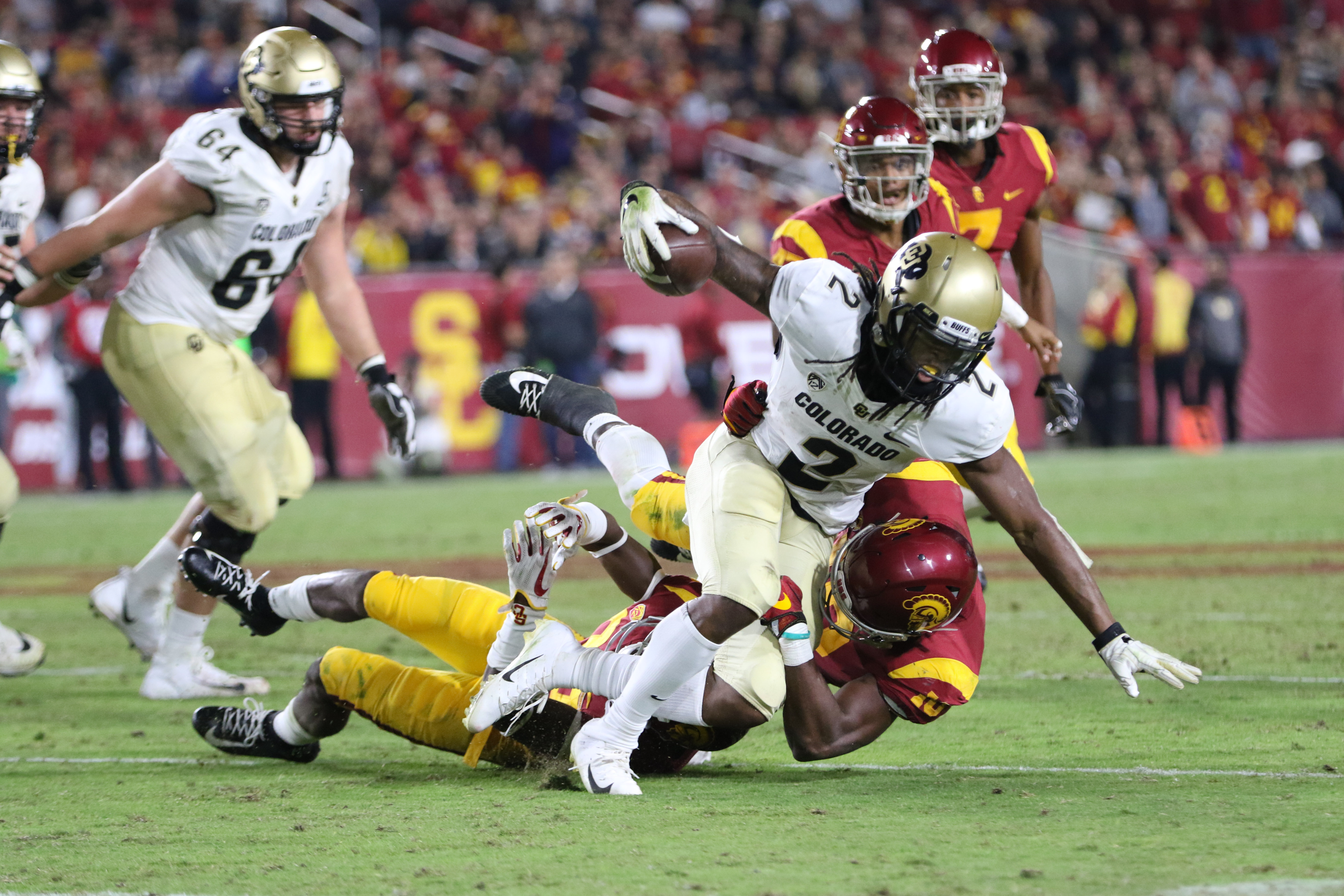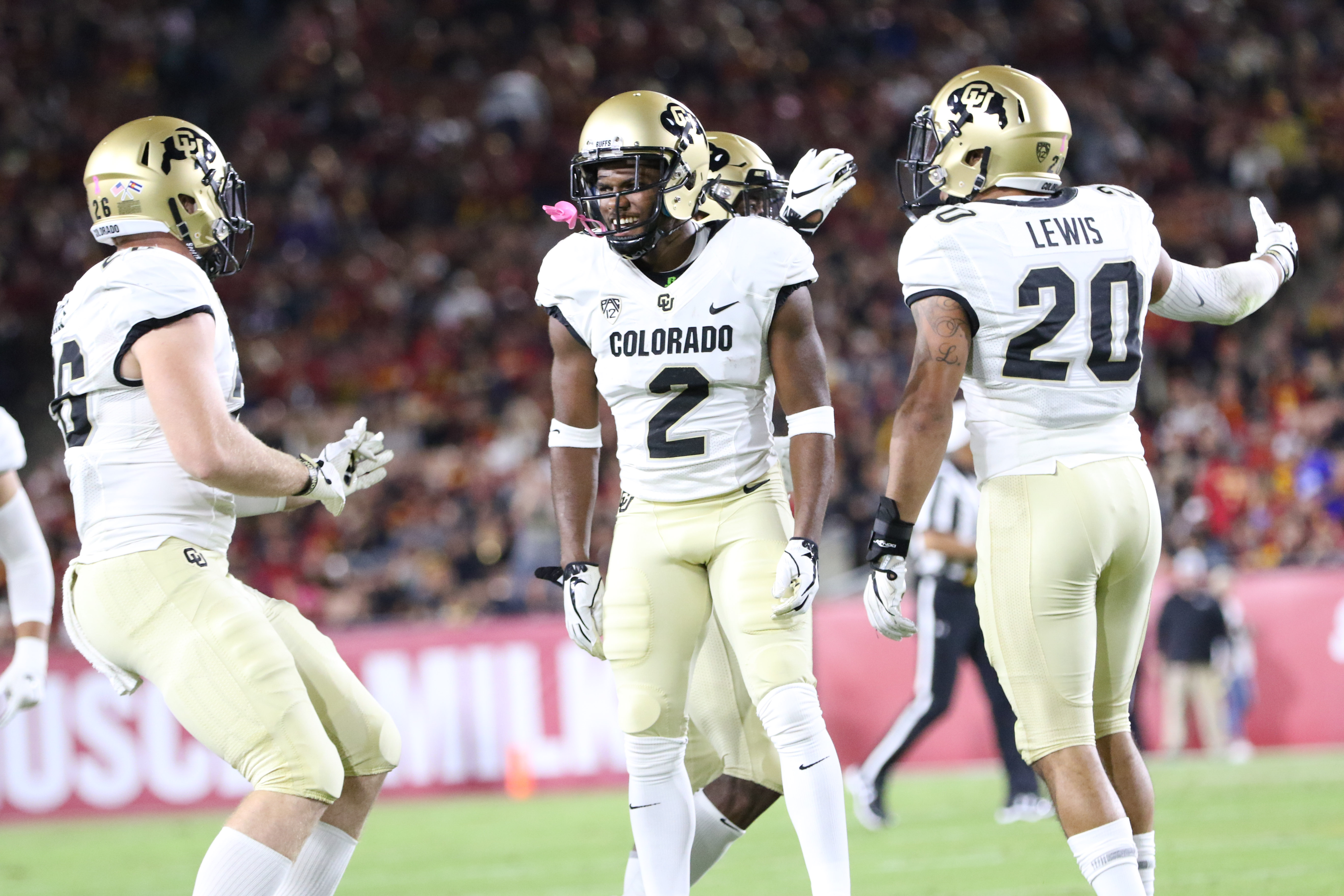
The USC Trojans took on the Colorado Buffaloes at the LA Coliseum on Oct. 13, 2018, in Los Angeles, California. (Photo by Josh Dunst/Daily Trojan)
After Colorado’s rough 31-20 loss on the road at Southern California this past Saturday, players, coaches and fans of the Buffaloes should make no mistake about this: the USC Trojans now are CU’s biggest rivals.
Disagree? What program other than Southern Cal has unrelentingly given the Buffs such trouble in the Mike MacIntyre era? The answer is no one.
“I think [USC] is a big rival,” MacIntyre said. “[Saturday was] a big game. There was a lot of emotion [and] energy before the game with the teams … We’ve got to win some [games] to make it a real rival[ry] and we haven’t in the history of the school, so we need to correct that somewhere down the road.”
The above answer is what I received when I asked MacIntyre directly if USC should be considered CU’s biggest conference rival. I’d consider it more of an essential non-answer, and I certainly understand the negative implications that could come with the territory of him explicitly saying that he and the Buffs are now out to get USC.
That said, I think the banality of MacIntyre’s response to my question does not do justice to the extreme frustrations that the Buffaloes have suffered at the hands of the Trojans since he became head coach at CU prior to the 2013 season.
“I think [playing USC] should be considering a rivalry game,” senior tailback Travon McMillian said. “They’ve beaten us every single time … for those guys next year, they just have to keep pushing, have a great mindset and [try] to dominate.”
Beginning with 2015’s matchup between Colorado and USC at Folsom Field, the Buffaloes have now played four straight games against the Trojans that, to a varying degree, they could have, should have and would have won.
Anyone that watched even a few minutes of Saturday’s loss at the L.A. Memorial Coliseum should understand that the manner in which Colorado lost falls in line with trends that have plagued the Buffs in their recent contests against the Trojans.
For example, on Saturday, the Buffaloes opened up the scoring in the second quarter on a 49-yard rushing touchdown by sophomore wide receiver Laviska Shenault, Jr. But after that touchdown, Colorado allowed the Trojans to score 28 unanswered points.
The Buffs dug themselves a big hole that, despite a fourth quarter in which CU outscored USC 13-3, ultimately doomed them.
Sound familiar?
On Nov. 11 of last year, when the then-ranked No. 15 Trojans played Colorado in Boulder, the Buffaloes let USC get a 27-0 lead before finally scoring their first touchdown of the game in the third quarter.
The final score of that game read 38-24 in favor of the Trojans, but just like a few days ago, the Buffaloes chose the fourth quarter to awaken and put points on the board. It cost them dearly.
In that game, the Buffs were fighting for their sixth win of the year and bowl eligibility, so one could go as far to say their sleepy play for most of the game held them back from a second straight postseason appearance.
I don’t buy that in 2017 the Buffaloes played the role of David while USC assumed the act of mighty Goliath. That contest at Folsom Field last year was winnable, just as it was this past Saturday, yet the Trojans in both cases came out on top.
Winding the clock back to 2016 when, in similar fashion to last Saturday, a ranked Colorado team hit the road to play the unranked Trojans at the Coliseum, the Buffaloes again were frustrated at the hands of Southern California.
At halftime, Colorado trailed 14-0 and punted in four out of five first half possessions, forfeiting the remaining drive on downs. The Buffs did tie the game at 14 late into the action, but, ultimately, the Trojans handed CU its lone conference loss of 2016, winning the game 21-17.
It should be acknowledged that Colorado had started Steven Montez in that game. Sefo Liufau in his senior season was dealing with an ankle injury he sustained a few weeks prior at Michigan and thus the Buffs’ offense was led by the then-freshman Montez.
Would Colorado have won that game with a healthy Liufau playing a full game? I suppose Buffs fans will never know. At the end of the day, CU (once again) failed to make any moves offensively until it was too late, but the direction the game would have taken if Colorado would have had the services of its starting signal caller is worth pondering.
The first year in the MacIntyre era when the Buffs put up a serious fight against the Trojans was 2015. It was also the first year that mishaps and misfortune ultimately contributed to CU losing to the Trojans.
In that game, Liufau was sacked roughly near the end of the first quarter and left the game immediately thereafter. It was later revealed that he had suffered a Lisfranc fracture, an injury that ended his 2015 campaign.
From the start of the second quarter, the Buffs were led by redshirt freshman quarterback Cade Apsay. Apsay, who was dismissed from the program in January of 2016 for violating team rules, came very close to toppling the mighty Trojans that night.
The Buffaloes enjoyed a 17-6 lead at halftime, but managed just seven points in the final half compared to USC’s 21. Apsay was sacked four times in the remaining two quarters, the Buffs had a field goal blocked and CU tailback Christian Powell fumbled in the third quarter, setting the Trojans up in Colorado territory and leading to a quick touchdown.
After such a promising start to the game, and a heck of a showing by Apsay, who completed 18-of-23 passes with two touchdowns and 128 yards of passing, the Buffs fell, 27-24.
The Colorado Buffaloes cannot rise to the next level until they can beat Southern California. By “next level,” I mean earning trips to higher profile bowl games and gaining more respect outside of the Pac-12 Conference.
Former Colorado head coach Bill McCartney defeated Nebraska for the first time during his fifth year as head coach at CU in 1986. For MacIntyre, he’ll have to hope that 2019, his seventh meeting with the Trojans, holds a bit of luck for his Buffaloes

LOS ANGELES, CA – OCTOBER 13 – The USC Trojans took on the Colorado Buffaloes at the LA Coliseum on October 13th, 2018 in Los Angeles, CA. (Photo by Josh Dunst / Daily Trojan)
Contact CU Independent Head Sports Editor Justin Guerrier at justin.guerriero@colorado.edu and follow him on Twitter @TheHungry_Hippo.
